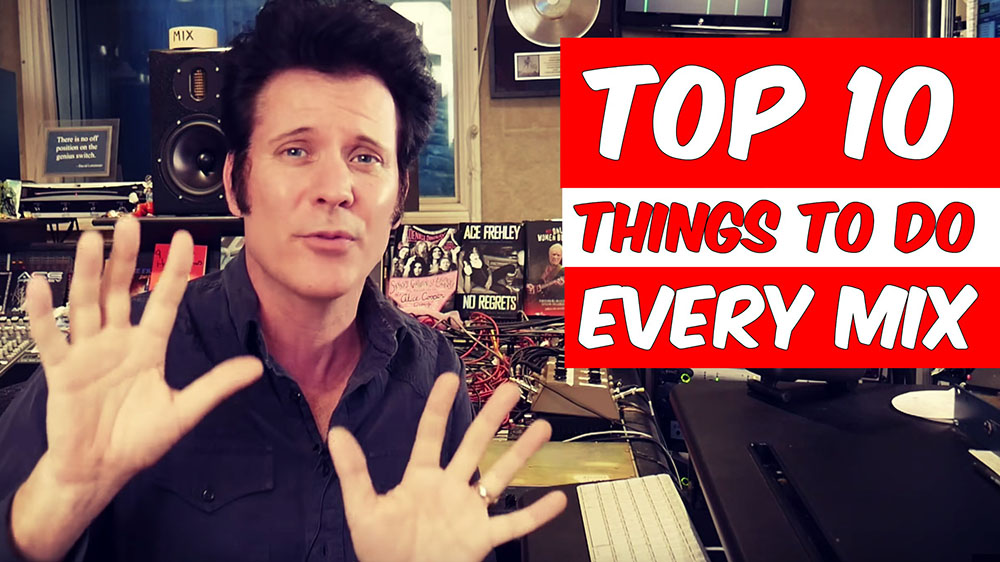1. Proper Gain Staging
Always leave enough headroom when mixing. Don’t max out every channel so that when it hits your Master bus the signal clipping heavily. Use Gain Plug ins (some DAWs have this built into the channel) or simply reduce the output going to your master bus from the channel fader. We can’t emphasize enough, the importance of proper gain staging.
2. Create Buses To Quickly and Effectively Mix Your Song
Divide the Song into Stereo Groups such as Drums, Bass, Electric Guitars, Acoustic, Keys, Programming, Background Vocals and lead vocal and send them all to their individual Buses. These Buses will help you mix
quickly and effectively.
3. High Pass Properly
Using High Passing Properly removing removes unwanted low frequency rumble. Vocals, Acoustic Guitars, Percussion and many other sources can pick up the sound of Air Conditioners and may other other sounds that will cloud the bottom and confuse the Low End Mix, leading to less definition in the Kick Drum and Bass.
4. Focus and Control the Low End
All great mixers have amazingly well controlled low end. The Kick and Bass can inherit cross over areas, however in a great mix if a Kick for example is boosted around 60 Hz and the Bass is Boosted around 80 Hz then there is very often a cross over point around 100-110 Hz, cut lightly from the Kick Drum the Bass will start to breath and the low end will feel bigger!
5. Compression, use it in Stages
The secret many Mix Engineers use is multiple sets of Compression, this is sometimes known as ‘serial compression’ when used on one source. However the real secret is compression not just on the Channel, but also when in a group sent to a Group Bus Compressor, even if very gentle. when applied it can add the Audio ‘glue’ you hear Pros talk about. Then lastly the Master Bus also has compression further giving extra energy to the Mix.
BONUS: View all of our Quick Mixing Tricks
6. Use Plug Ins to give an additional Sonic Stamp and Character to your Mix
Have you ever wondered the reason for the multiple plug in Compressors and EQs on the market? The enormous amount of emulations of classic/legendary pieces of gear? Well, here is the secret, not all Compressors and EQs are created equal! While the stock plugins in ANY DAW will do an amazing job to control the dynamics of a sound, emulations and other great plug in Compressors and EQs will not only control Dynamics and EQ but impart a sound, a character on the mix.
7. Don’t Be Afraid To Use Parallel Compression
So many great mixers use Parallel A LOT! Typically a drum mix compressed aggressively in parallel pushed up underneath the main drum bus will add a huge amount of energy even before feeling that loud! Vocal Parallel compression adds energy to the singers performance, a Parallel Compressor on a lightly played Acoustic arpeggio will bring the smallest pieces of articulation up.
8. Pan Your Instruments to create Space and Width in Your Mix
Moving things from the Centre will create space for your Lead Vocal, Kick, Snare and Bass Guitar to stand out. Having guitars and keys wide will also crate greater width! A common trick amongst all great mixers is to use 50% or less panning in the verses and then go full 100% Left and Right on heavy guitars for instance to get the Chorus to jump out of the speakers!
9. Use Reverbs and Delays to create Space and Depth
Reverbs and Delays are a not so secret weapon in the Professional Mixers arsenal. Mixers such as Michael Brauer and Chris Lord Alge use multiple sets of of them, featuring different lengths of reverbs at different sections of the song. Not all effects are made to heard loudly at all! A touch of Delay or Reverb can help create depth to an instrument and space, placing it in a different place to the sounds that surround and just giving it enough separation from them.
READ ALSO: Best ASMR Microphones
READ ALSO: Lancaster Audio Impulse Responses Review
READ ALSO: 9 Best Rhodes VSTs
10. Automation! Use it!
This could be the most important one of all! Great mixers use automation mixing tricks to push forward and feature vocals and instruments and also duck them to play a supporting role when needed. Automation can take a little extra time at the end of the mix but will definitely give your mix is very professional feel!
